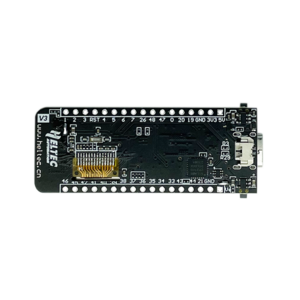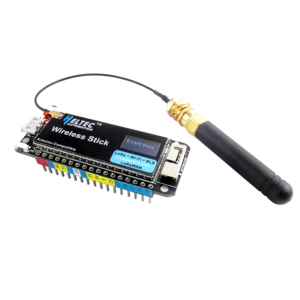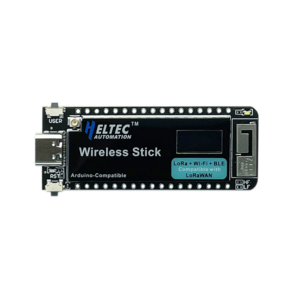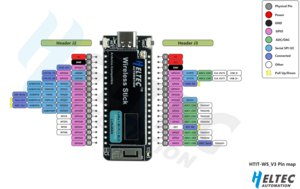Схема соответствует действительности, по схеме можно определить подключение периферийных устройств
Инициализация дисплея:
библиотека https://github.com/ThingPulse/esp8266-oled-ssd1306.git
#include "SSD1306Wire.h"
#define RST_OLED 21
#define SCL_OLED 18
#define SDA_OLED 17
SSD1306Wire display(0x3c, SDA_OLED, SCL_OLED, GEOMETRY_64_32);
pinMode(RST_OLED, OUTPUT);
digitalWrite(RST_OLED, HIGH);
delay(5);
digitalWrite(RST_OLED, LOW);
delay(5);
digitalWrite(RST_OLED, HIGH);
delay(5);
display.init();
// Set display contrast
// really low brightness & contrast: contrast = 10, precharge = 5, comdetect = 0
// normal brightness & contrast: contrast = 100
display.setContrast(255);
display.setBrightness(255);
display.flipScreenVertically();
display.displayOn();
// display.displayOff();
Инициализация радио модуля:
библиотека https://github.com/jgromes/RadioLib.git
#include <RadioLib.h>
#define NSS 8
#define DIO1 14
#define NRST 12
#define BUSY 13
SX1262 radio = new Module(NSS, DIO1, NRST, BUSY);
Потребление в режиме light_sleep с включенным дисплеем и радиомодулем от батареи - 10мА, от 5В - 18мА.
Дальность связи в городе 433 FSK с родными антеннами около 300 метров.
Description
1.1 Overview
HTIT-WS is a development board for Wi-Fi, Bluetooth and LoRa. Its functions are
basically the same as “WiFi Lora 32”, except that the screen is reduced to 0.49 inch and
a shielding shell is added.
The HTIT-WS is composed up of an MCU (ESP32-S3FN8) and Semtech LoRa Transceivers
(SX1262), perfectly support Arduino®. Users can easily carry out secondary
development and application.
The V3 version is upgraded as follows:
| HTIT-WS (V2) | HTIT-WS (V3) | |
| MCU | ESP32-D0 | ESP32-S3 |
| LoRa Chip | SX1276 | SX1262 |
| USB Socket | Micro USB | Type C |
| Crystal Oscillator | Ordinary crystal oscillator | High precision temperature compensated crystal oscillator |
| Low power features in deep sleep | 800uA | <10uA |
| Other | Better impedance matching of RF circuits |
Wireless Stick Lite are available in two product variants:
| HTIT-WS-LF | 470~510MHz working LoRa frequency, used for China mainland (CN470) LPW band. |
| HTIT-WS-HF | For EU868, IN865, US915, AU915, AS923, KR920 and other LPW networks with operating frequencies between 863~928MHz. |
1.2 Product features
➢ Microprocessor: ESP32-S3FN8 (Xtensa® 32-bit LX7 dual core processor, five stage
pipeline rack Structure, main frequency up to 240 MHz).
➢ SX1262 LoRa node chip.
➢ Type-C USB interface with a complete voltage regulator, ESD protection, short
circuit protection, RF shielding, and other protection measures.
➢ Onboard SH1.25-2 battery interface, integrated lithium battery management
system (charge and discharge management, overcharge protection, battery power
detection, USB / battery power automatic switching).
➢ Integrated WiFi, LoRa, Bluetooth three network connections, onboard Wi-Fi,
Bluetooth dedicated 2.4GHz metal spring antenna, reserved IPEX (U.FL) interface
for LoRa use.
➢ Onboard 0.49-inch 64*32 dot matrix OLED display, which can be used to display
debugging information, battery power, and other information.
➢ Integrated CP2102 USB to serial port chip, convenient for program downloading,
debugging information printing.
➢ Support the Arduino development environment.
➢ We provide ESP32 + LoRaWAN protocol Arduino® library, this is a standard
LoRaWAN protocol that can communicate with any LoRa gateway running the
LoRaWAN protocol. In order to make this code running, a unique license is needed.
it can be found on this page;
➢ With good RF circuit design and low-power desig
3. Specifications
3.1 General specifications
| Parameters | Description |
| Master Chip | ESP32-S3FN8 (Xtensa®32-bit lx7 dual core processor) |
| LoRa Chipset | SX1262 |
| USB to Serial Chip | CP2102 |
| Frequency | 470~510 MHz, 863~928 MHz |
| Max. TX Power | 21 ± 1 dBm |
| Max. Receiving sensitivity | -139 dBm |
| Wi-Fi | 802.11 b/g/n, up to 150Mbps |
| Bluetooth | Bluetooth LE: Bluetooth 5, Bluetooth mesh |
| Display | 0.49-inch OLED |
| Hardware Resource | 7*ADC1 + 2*ADC2; 7*Touch; 3*UART; 2*I2C; 2*SPI; etc. |
| Memory | 384KB ROM; 512KB SRAM; 16KB RTC SRAM; 8MB SiP Flash |
| Interface | Type-C USB; 2*1.25 lithium battery interface; LoRa ANT(IPEX1.0); 2*17*2.54 Header Pin |
| Battery | 3.7V lithium battery power supply and charging |
| Operating temperature | -20 ~ 70 ℃ |
| Dimensions | 58.08 * 22.6* 8.2 mm |
3.5 LoRa RF characteristics
3.5.1 Transmit power
| Operating frequency band | Maximum power value/[dBm] |
| 470~510 | 21 ± 1 |
| 867~870 | 21 ± 1 |
| 902~928 | 21 ± 1 |
3.5.2 Receiving sensitivity
The following table gives typically sensitivity level of the HTIT-WS.
| Signal Bandwidth/[KHz] | Spreading Factor | Sensitivity/[dBm] |
| 125 | SF12 | -139 |
| 125 | SF10 | -130 |
| 125 | SF7 | -124 |
3.6 Operation Frequencies
HTIT-WS supports LoRaWAN frequency channels and models corresponding table.
| Region | Frequency (MHz) | Model |
| EU433 | 433.175~434.665 | HTIT-WS-LF |
| CN470 | 470~510 | HTIT-WS-LF |
| IN868 | 865~867 | HTIT-WS-HF |
| EU868 | 863~870 | HTIT-WS-HF |
| US915 | 902~928 | HTIT-WS-HF |
| AU915 | 915~928 | HTIT-WS-HF |
| KR920 | 920~923 | HTIT-WS-HF |
| AS923 | 920~925 | HTIT-WS-HF |
-
| Вложение | Размер |
|---|---|
| sam_0750_800x800.png | 278.18 КБ |
| ht-wsv3.png | 269.55 КБ |
| htit-ws_v3.png | 1.99 МБ |
| htit-ws_v3_schematic_diagram.pdf | 182.24 КБ |
| esp32_technical_reference_manual_en.pdf | 9.19 МБ |
| esp32-s3_datasheet_en.pdf | 1.13 МБ |
| 1537522406ds_sx1261-2_v1_1_semtech.pdf | 2.31 МБ |
| xcom_v2_0.zip | 222.41 КБ |
| Пример platformio.ini | 1.41 КБ |
| pins_arduino.h | 2.26 КБ |



